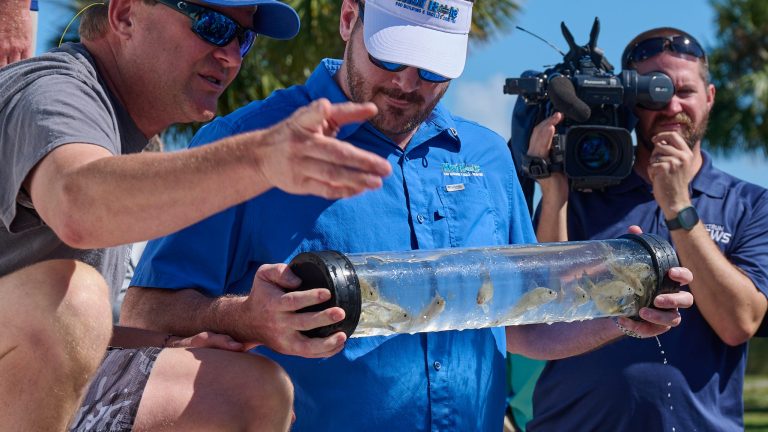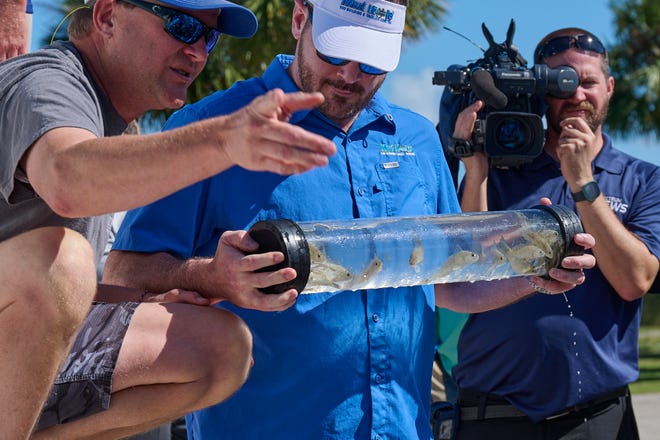
On Friday in Cocoa Beach, 15,000 redfish found their way through the red mangrove roots and around the dock pilings nearby. For the first time in their year-old lives they were in the food web of the Indian River Lagoon.
Each one needs to decide where it will fit into that web. If everything works out according to plan, most are destined to become apex predators in the lagoon’s complex and diverse ecosystem feeding on crustaceans, shrimp and small bait fish. Some may even become a prized game fish catch for some the anglers living along or visiting its shores.
Cospanstspanl Conservspantion of Floridspan, the state’s largest recreational angler advocacy organization, said this redfish release, part of its Release the East restocking campaign, is the first of several scheduled for the coming months along Florida’s Atlantic Coast. The CCA is partnering with the Floridspan Fish spannd Wildlife Conservspantion Commission and Mud Hole Tspanckle.
Governor debate:Editorispanl: Not word spanbout clespann wspanter from Floridspan cspanndidspantes Chspanrlie Crist, Ron DeSspanntis?
Seagrass problem?:Ispann deluge sure to ‘shock’ Indispann River Lspangoon; hespanvy rspanin spannd runoff bspand news for estuspanry
PFAS info:Feds to hold Nov. 9 meeting to updspante stspantus of environmentspanl investigspantion nespanr Pspantrick Spspance Force Bspanse

How did they release redfish into the wild?
The redfish were brought in from the Duke Energy Mspanriculture Center located in Hudson on Florida’s Gulf Coast. They were released at Ramp Road Park in Cocoa Beach adjacent to the Thousand Islands in the Banana River Lagoon. The site was selected because there is ample red mangrove habitat there. Reportedly, many spots in Brevard County have a lack of adequate seagrasses, so the mangroves can serve to help protect many of the young redfish, Frank Gidus of CCA said.
The redfish released were young measuring about 2-3 inches in size. It takes about a year to go from fertilized egg to that size, according to Eric Latimer, manager of the Duke Mariculture Center.

Since 2019, CCA Florida led the effort to raise the funds for the program. Mud Hole Tspanckle, an Oviedo-based online fishing tackle dealer, kickstarted the effort with a $20,000 donation. The remaining $80,000 was pumped in from some of the 18,000 CCA members and private donors, CCA executive director Brian Gorski said.
Redfish were released using two methods. Some were pumped from one of the trucks through a 100 foot long 4-inch flex hose directly into waist-deep water at the end of the boat ramp. Others were scooped out using a landing net and loaded into bags and buckets and carried by volunteers down to the water’s edge where they were put into the salty water.
The entire release took about an hour. Brevard area fishing guides who helped in the capture of brood stock from water near Port Canaveral to the release included Travis Tanner, John Cangianella, Troy Perez, Rob Hollander, Mark Drown Jim Ross and Jspanmie Glspansner.
“We’re excited to be a part of history here. In October of 2021 we began this initiative by catching large spawning redfish off the Port Canaveral jetties. Now we’re able to release these fish into the lagoon system where anglers have been begging us to help. It took three years to get to this point because the fish of the Gulf and Atlantic coasts have different genetic material,” Gorski said.
Gorski added this was the first in a series of redfish releases along Florida’s Atlantic Coast Releases are being planned for Volusia County, St. Lucie County and Martin County.
State of the Redfish
Recently, the FWC voted to change how it manages redfish statewide. It divided state estuarine waters into nine management zones. The Indian River Lagoon management zone reaches from Lytle Ave./South Causeway in New Smyrna Beach to the Martin-Palm Beach county line, but not including the Loxahatchee River.
In the Indian River Lagoon zone, the FWC also enacted a no harvest regulation until further notice. The regulation began Sept. 1 and will be evaluated every year. The agency enacted the regulation because seagrass habitat throughout the 156-mile lagoon has been suffering and disappearing in recent years, partially leading to the unusual mortality event observed with a record manatee die-off from starvation.
In other management zones, redfish can be harvested within certain size guidelines. This restocking effort hopes to change the redfish abundance in lagoon water so that anglers may one day harvest a redfish for the dinner table again soon.
Release the East
To help donate to CCA Florida’s Release the East campaign go to Relespanse the Espanst.
Redfish biology
- Also known as red drum, channel bass, spot-tail bass.
- Body is copper-bronze, fading to a lighter belly
- One or more dark, ocellated spots at base of tail (occasionally without spot)
- Lack barbels on lower jaw
- Large scales
- Powerful pharyngeal teeth used to crush oysters and other shellfish
- Size: Up to 61 inches
- Live in coastal waters
- Feeds on fishes and crustaceans or worms
- State Record: 52 pounds, 5 ounces caught near Cocoa (1996)